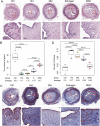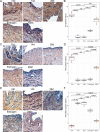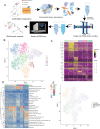Human umbilical cord blood-derived MSCs trans-differentiate into endometrial cells and regulate Th17/Treg balance through NF-κB signaling in rabbit intrauterine adhesions endometrium
- PMID: 35841027
- PMCID: PMC9284747
- DOI: 10.1186/s13287-022-02990-1
Human umbilical cord blood-derived MSCs trans-differentiate into endometrial cells and regulate Th17/Treg balance through NF-κB signaling in rabbit intrauterine adhesions endometrium
Abstract
Purpose: The fundamental cause of intrauterine adhesions (IUAs) is the destruction and reduction in stem cells in endometrial basal layer, resulting in endometrial reconstruction very difficult. The purpose of this study was to investigate the effects and underlying mechanism of human umbilical cord blood-derived mesenchymal stem cells (hUCB-MSCs) on the endometrial reconstruction after transplantation.
Methods: hUCB-MSCs were isolated and identified by flow cytometry, osteogenic, adipogenic and chondrogenic differentiation assays. The rabbit IUA models were established and set five groups (control, 14/28th day after surgery, estrogen and hUCB-MSCs treatment). The number of endometrial glands and the fibrosis rate were evaluated using HE and Masson staining, respectively. Endometrial proliferation, angiogenesis and inflammation were evaluated by immunohistochemical staining of ER, Ki-67and TGF-β1, respectively. Single-cell RNA sequencing (scRNA-seq) was applied to explore the cell differentiation trajectory after hUCB-MSCs transplanted into IUA endometrium. Finally, molecular mechanism of hUCB-MSCs repairing damaged endometrium was investigated by RNA sequencing, qRT-PCR and Western blot assays.
Results: After transplantation of the hUCB-MSCs, the increase in endometrial gland number, estrogen receptor (ER) and Ki-67 expression, and the decrease in fibrosis rate and TGF-β expression (P < 0.05), suggested the endometrial repair, angiogenesis and inflammatory suppression. The therapeutic effect of hUCB-MSCs was significantly improved compared with 28th day after surgery and estrogen group. ScRNA-seq demonstrated that the transplanted hUCB-MSCs can trans-differentiate into endometrial cells: epithelial, fibroblast and macrophage. RNA sequencing of six IUA samples combined with qRT-PCR and Western blot assays further revealed that hUCB-MSCs may regulate Th17/Treg balance through NF-κB signaling, thus inhibiting the immune response of damaged endometrium.
Conclusions: Our study demonstrated that hUCB-MSCs can repair damaged endometrium through trans-differentiation, immunomodulatory capacities and NF-κB signaling, suggesting the treatment value of hUCB-MSCs in IUA.
Keywords: Human umbilical cord blood-derived mesenchymal stem cells (hUCB-MSCs); Intrauterine adhesion (IUA); NF-κB signaling; Trans-differentiation; scRNA-seq.
© 2022. The Author(s).
Conflict of interest statement
The authors declare no competing interests.
Figures






Similar articles
-
[Effect of mesenchymal stem cell derived from umbilical cord blood on rabbit intrauterine adhesion model].Zhonghua Yi Xue Za Zhi. 2024 Oct 29;104(40):3757-3764. doi: 10.3760/cma.j.cn112137-20240314-00578. Zhonghua Yi Xue Za Zhi. 2024. PMID: 39463370 Chinese.
-
Human embryonic stem cell-derived immunity-and-matrix-regulatory cells promote endometrial repair and fertility restoration in IUA rats.Stem Cell Res Ther. 2025 Apr 23;16(1):204. doi: 10.1186/s13287-025-04298-2. Stem Cell Res Ther. 2025. PMID: 40269948 Free PMC article.
-
Bone marrow mesenchymal stem cells combined with estrogen synergistically promote endometrial regeneration and reverse EMT via Wnt/β-catenin signaling pathway.Reprod Biol Endocrinol. 2022 Aug 15;20(1):121. doi: 10.1186/s12958-022-00988-1. Reprod Biol Endocrinol. 2022. PMID: 35971112 Free PMC article.
-
Evolution of biotechnological advances and regenerative therapies for endometrial disorders: a systematic review.Hum Reprod Update. 2024 Oct 1;30(5):584-613. doi: 10.1093/humupd/dmae013. Hum Reprod Update. 2024. PMID: 38796750 Free PMC article.
-
Interceed combined with bone marrow mesenchymal stem cells improves endometrial receptivity of intrauterine adhesion.Regen Ther. 2024 Apr 25;27:445-454. doi: 10.1016/j.reth.2024.04.007. eCollection 2024 Dec. Regen Ther. 2024. PMID: 38706569 Free PMC article. Review.
Cited by
-
Exploring the future potential of mesenchymal stem/stromal cells and their derivatives to support assisted reproductive technology for female infertility applications.Hum Cell. 2023 Sep;36(5):1604-1619. doi: 10.1007/s13577-023-00941-3. Epub 2023 Jul 5. Hum Cell. 2023. PMID: 37407748 Review.
-
Exploring the application value of ultrasound in animal studies of stem cell therapy for intrauterine adhesions.Sci Rep. 2025 Aug 11;15(1):29319. doi: 10.1038/s41598-025-14996-9. Sci Rep. 2025. PMID: 40789897 Free PMC article.
-
Semaglutide May Ameliorate Fibrosis and Inhibit Epithelial-Mesenchymal Transition in Intrauterine Adhesion Models.Int J Mol Sci. 2024 Jun 4;25(11):6196. doi: 10.3390/ijms25116196. Int J Mol Sci. 2024. PMID: 38892384 Free PMC article.
-
Application of biomaterials in mesenchymal stem cell based endometrial reconstruction: current status and challenges.Front Bioeng Biotechnol. 2025 Jan 29;13:1518398. doi: 10.3389/fbioe.2025.1518398. eCollection 2025. Front Bioeng Biotechnol. 2025. PMID: 39944223 Free PMC article. Review.
-
Mesenchymal Stem Cells Accelerate Recovery of Acetic Acid-Induced Chronic Gastric Ulcer by Regulating Ekt/Akt/TRIM29 Axis.Stem Cells Int. 2024 Jan 3;2024:6202123. doi: 10.1155/2024/6202123. eCollection 2024. Stem Cells Int. 2024. PMID: 38213743 Free PMC article.
References
-
- Lin X, Zhang Y, Pan Y, He S, Dai Y, Zhu B, Wei C, Xin L, Xu W, Xiang C, et al. Endometrial stem cell-derived granulocyte-colony stimulating factor attenuates endometrial fibrosis via sonic hedgehog transcriptional activator Gli2. Biol Reprod. 2018;98(4):480–490. doi: 10.1093/biolre/ioy005. - DOI - PubMed
Publication types
MeSH terms
Substances
LinkOut - more resources
Full Text Sources
Medical
Molecular Biology Databases

